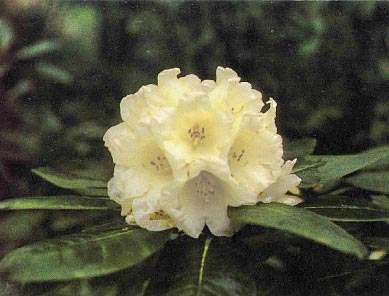QBARS - v33n3 Rhododendron lacteum
Rhododendron lacteum
Dave Goheen, Camas, WA.

|
|
R. lacteum
Del James form
Photo by Dave Goheen |
In the whole genus, Rhododendron , there is probably no finer species than R. lacteum . In almost all flowering traits, this rhododendron is superb. Its faults are summed up in the paragraph in the 1967 Species Handbook of the RHS, "Very beautiful when well grown, but on the whole of poor constitution, often not long lived, slow growing, reluctant to set seeds and difficult to propagate by layering". True words - all of them. Fortunately, these drawbacks can be overcome and grafted plants on various root stocks can be fairly easily grown into magnificent garden specimens. About twelve years ago, I obtained scions from the plant originally grown as a graft by Del James in Eugene, Oregon. The scions were grafted to two branches of a young plant of R. discolor . This union has flourished and I now have a vigorous plant of some seven feet in height and six feet in width. The leaves are deep green and somewhat bullate. This year at least fifteen full and beautiful trusses bloomed. There is some evidence of incompatibility at the graft union but, on the whole, the plant appears healthy and puts forth vigorous new growth shoots. I expect it to flourish for many more years.
The reasons for R. lacteum not doing well on its own roots are now known very well. There is some evidence that the plant may require very much more acidic soils than other rhododendrons - as low as pH 3.5 has been suggested. I do not know if this has every been verified experimentally. Perhaps not all forms of R. lacteum need be grafted. I have a seven year old seedling that seems to be thriving on its own roots and have heard of other in Scotland. But I must say that better specimens result from grafting.
The Del James form, that I have, blooms with an almost perfectly formed, rounded, tight truss with two inch long, broadly campanulate flowers of light yellow color, with light pink staining which gradually fades. There may be (and in fact are) forms that are more yellow but there are certainly none which are more perfectly formed.
Until it can be determined why R. lacteum does not do well on its own roots, we shall have to be content with grafted plants. I have found the graft onto R. discolor to be satisfactory in all respects. The plant is hardy and experienced no leaf or bud damage in last winter's severe, dry and cold East winds. One peculiar trait has been observed. During rapid growth in the spring, the plant requires continuous (or nearly so) irrigation. If allowed to go more than a few days without rain or irrigation water, the leaves develop a peculiar, contorted appearance near their apex. Thus R. lacteum , at least on R. discolor root stocks, needs ample moisture during the rapid growing period in order to develop fully its fine, dark green leaves.
